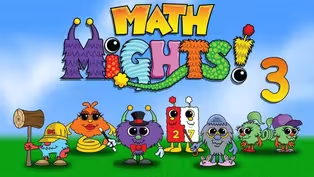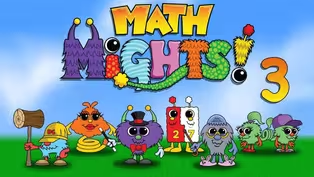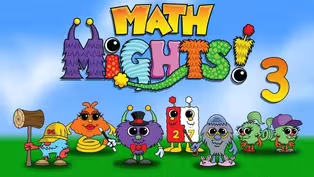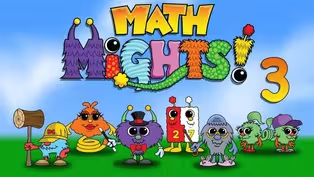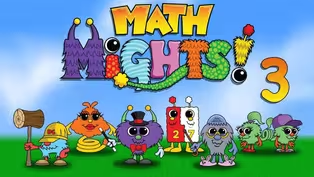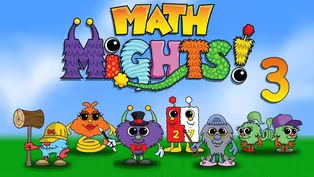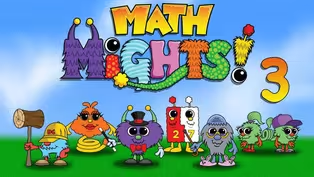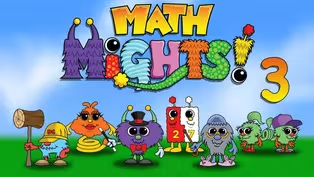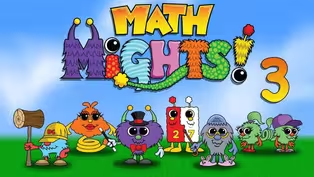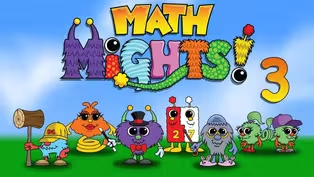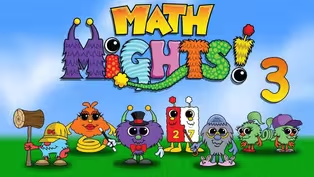Math Mights
Dividing with Larger Quotients
Season 3 Episode 303 | 15m 59sVideo has Closed Captions
Join Ms. Askew and Professor Barble to see if you can match visual models to word problems
Join Ms. Askew and Professor Barble to see if you can match visual models to word problems. Get ready to put your thinking cap on as we work on division with larger numbers within word problems. How many stratgies do you have for division?
Problems playing video? | Closed Captioning Feedback
Problems playing video? | Closed Captioning Feedback
Math Mights is a local public television program presented by Detroit PBS
Math Mights
Dividing with Larger Quotients
Season 3 Episode 303 | 15m 59sVideo has Closed Captions
Join Ms. Askew and Professor Barble to see if you can match visual models to word problems. Get ready to put your thinking cap on as we work on division with larger numbers within word problems. How many stratgies do you have for division?
Problems playing video? | Closed Captioning Feedback
How to Watch Math Mights
Math Mights is available to stream on pbs.org and the free PBS App, available on iPhone, Apple TV, Android TV, Android smartphones, Amazon Fire TV, Amazon Fire Tablet, Roku, Samsung Smart TV, and Vizio.
Providing Support for PBS.org
Learn Moreabout PBS online sponsorshipMore from This Collection
Video has Closed Captions
Join Ms. Askew for a tricky multi-step word problem with Professor Barble! (15m 59s)
Build Fraction from Unit Fractions
Video has Closed Captions
Join Ms. Askew for another multi-step word problem with Professor Barble! (15m 59s)
Video has Closed Captions
Join Ms. Askew for a division word problem with her friend Professor Barble. (15m 59s)
Video has Closed Captions
Join Ms. Askew for a division word problem with her friend Professor Barble. (16m)
Video has Closed Captions
Join Ms. Askew and Professor Barble to do a visual model with a word problem. (15m 59s)
Dividing with even larger numbers
Video has Closed Captions
Join Ms. Askew and Professor Barble to do a visual model with multiplication. (15m 59s)
Video has Closed Captions
Join Ms. Askew and Professor Barble to see if you can match visual models to word problems (15m 59s)
Video has Closed Captions
Learn about multiplying one-digit whole numbers by multiples of 10. (15m 59s)
Video has Closed Captions
Learn about multiplying numbers larger than 20. (16m)
Video has Closed Captions
Join Mrs. Askew for a Number Talk with 2 Math Might Friends! (16m)
Multiply Teen Numbers with Larger Groups
Video has Closed Captions
Join Mrs. Askew for a Number talk with 2 Math Might Friends! (15m 59s)
Relating Multiplication and Division
Video has Closed Captions
Join Ms. Askew for a subtraction number talk with Springling! (16m)
Providing Support for PBS.org
Learn Moreabout PBS online sponsorship(upbeat music) - [Children] Math Mights.
- Welcome third grade math might friends.
My name is Ms. Askew.
I'm so happy that you joined us today.
We're gonna have so much fun learning about math.
So let's check out our plan for today.
First, we're gonna do a word problem with our friend Professor Barble.
After that, we're going to divide with larger quotients.
Let's warm up our math brains with our friend, Professor Barble as we conquer word problems with visual models.
You might be asking yourself, what is a visual model Ms. Askew?
Sometimes a visual model is known as a model drawing, unit bar, tape diagram or bar model.
It is a reading comprehension strategy for word problems.
Drawing a visual model helps to visualize the strategies and understand what the word problem is asking.
I wonder who's gonna help us today.
I think it might be our math might friend, Professor Barble.
Professor Barble is a math might friend who lives in Mathville.
He likes to take hikes all throughout Mathville trying to solve word problems.
He used to go straight into solving those problems without even thinking about it.
So he's learning that in order to solve those problems you must first go slow, in order to go fast by following a step-by-step process that helps you walk through how to think about what the problem is asking.
As Professor Barble solves those problems, he puts on his thinking cap and a bar comes out the top of his thinking cap to help him create a visual model for the word problem.
Today, we're gonna guess what Professor Barble story problem would be.
Taking a look at this visual model, can you guess what Professor Barble's story problem was?
I wonder what made Professor Barble create that visual model?
Let's take a look and see what Arti thinks.
Arti says, "I think we need to multiply to find out how many diamonds in all."
Wait Arti, we don't wanna solve the problem, we wanna guess what the story problem is from what Professor Barble read, in order for him to create that visual model.
Let's see what Ceena thinks, Ceena says "Professor Barble has six bags with seven diamonds in each bag.
How many diamonds does he have in all?"
We're going to begin with our starting line from Professor Barble's thinking cap.
Now we wanna label it so that we know what that starting line represents.
In the story we know that we are talking about the diamond collection.
So we're going to label the starting line, diamond collection.
Now we're going to create a unit bar.
This comes out from the starting line.
Do we know how many diamonds?
Not yet, that's the unknown.
That's why we put the question mark there.
So we wanna take that unit bar and divide it into six sections.
And in each of those sections we're going to put seven diamonds.
We wanna make sure we label what that unit bar represents, the bags.
Does that help you to understand Professor Barble's visual model just a little bit better?
It sure helped me.
How does the visual model help you to understand what the story problem is asking?
I know that solving word problems can be a little overwhelming for third graders, but when you create a visual model it helps you to slow down in order to go fast so that it helps you to think about what the story problem is asking so you don't have to guess, do I add?
Do I subtract?
Do I multiply or divide?
I now have a visual understanding of what the problem was asking.
I see that there are six groups of seven.
So that means I need to multiply.
Six groups of seven equals 42.
Wow, that visual model really helped with my understanding.
Great job third graders as you watch Professor Barble use the visual model to solve word problems.
We're going to do lots more with that today but first let's check out our I can statement for the day.
I can divide with larger numbers within story problems.
Maria's class is splitting into groups to go on a field trip to the aquarium.
What do you notice?
What do you wonder?
Have you ever been on a field trip before?
Where have you gone?
And when you went on that field trip, how were you divided into groups?
Arti notices that they are going to the aquarium in groups but they can't all go together.
Ceena wonders how many kids are in the class?
How many kids in each group?
Are the groups going to be equal?
Those were all great wonders and notices.
Let's read the story problem to see how it goes along with the scenario.
There are 48 students going on a field trip to the aquarium.
They are put into groups of four students.
How many students are in each group?
Arti thinks we should multiply.
Wait, Ceena thinks maybe we should divide.
Wait a minute, you guys are trying to solve the problem and that doesn't come until step six.
What we wanna do is figure out what the problem is asking us to do so we don't have to guess, do I add?
Subtract?
Multiply or divide?
Let's take a look at Professor Barble's step-by-step visual model checklist.
These are steps to help us better understand how to solve word problems.
Let's go through them together slowly.
The first step is to read the entire problem and then put it into chunks.
I'm gonna read the story problem first and then you're gonna read it after me and we're gonna put it into chunks, let's try it.
There are 48 students going on a field trip to the aquarium.
They are put into groups of four students.
How many students will be in each group?
Now it's your turn to read it and let's chunk the information.
There are 48 students going on a field trip to the aquarium, chunk.
They are put into groups of four students, chunk.
How many students will be in each group?
Chunk.
Why do we make the chunks when reading a story problem?
When we chunked the story problem it helps us to get a better understanding of what the story problem is asking us to do.
Step two, we're going to rewrite the question in a sentence form with a blank space for the answer there will be blank students in each group.
You might be asking yourself why are we writing the question in sentence form?
As third graders we often times wanna rush in and try to solve the problem.
By writing the question in sentence form it helps us to slow down and think about what the question is.
Now it's time for Professor Barble to help us by putting on his thinking cap so we can create a visual model to help us solve the problem.
Step three, we need to determine the who and or the what that's involved in the problem.
The students are the who and the field trip is the what.
The first thing that we wanna do is draw a starting line.
Don't forget to label it.
It represents the students on the field trip.
Next we're going to draw the unit bar.
You might be wondering what that unit bar represents.
Well, let's go back to our whiteboard.
The unit bar represents the students on the field trip.
Now let's work on step five.
We're going to go back to the chunks and check when each part is added into the adjusted unit bars and put a question mark, let's try it.
We know that reading the first sentence that there are 48 students going on a field trip to the aquarium.
On the white board we're going to label that, 48 students are going on the field trip.
Looking back at our story problem we're going to check that information off.
The next sentence is they are put into groups of four students.
We know that we now have to divide our unit bar into four sections.
We're going to use three lines because three lines will help us create those four sections.
Don't forget to label it.
This represents the groups.
Now let's go back to our story problem and check that information off.
Finally, we're going to read our question.
How many students are in each group?
Now let's put the question mark in one of our unit boxes because that's the information that we're trying to figure out.
How many students are in each group?
Now let's go back and check it off.
Great job third graders.
We have three chunks and three checks.
Anyone who looks at your visual model can tell what the story problem was about just by looking at what you created.
How cool is that?
Now Arti can see by looking at our visual model that we need to divide and not multiply.
See boys and girls going slow to go fast actually helps.
Now let's go to step six.
This is the part that you've all been waiting for.
Let's correctly compute and solve the problem.
Ceena wonders if we can use place value disks to solve this.
Let's take a closer look and act it out on our whiteboard.
We have our division problem, 48 divided by four and we're gonna use our place value disk.
We have the total number of 48 which is also called the dividend.
We're gonna take that dividend and divide it into four equal groups.
The four in our story problem represents the divisor or how many groups we have.
Now let's go ahead and divide it equally.
Looking at our groups we see that there are 12 students.
Remember they were the ones going on the field trip in each of those groups.
So 48 divided by four equals 12 students in each group.
Our final step is step seven.
Write the answer in the sentence and make sure the answer makes sense.
48 divided by four equals 12.
There will be 12 students in each group.
Great job third grade math mights.
I know for some of you that might have been the first time that you use Professor Barble's step-by-step process to solve word problems, but you did an awesome job.
Let's see if there are more ways to solve division problems.
Let's take a look at the problem we just solved.
What are other ways that we could solve this problem, 48 divided by four?
Arti wonders if we can multiply-up to divide as a strategy to find the answer?
As you can see, we have our friends Springling you know that she likes to hop on an open number line to solve subtraction problems but did you know that she can also hop in chunks to multiply-on, to solve division problems?
Let's walk through this slowly.
We see the problem 48 divided by four, the 48 is our target number.
It represents the number of students that are going on the field trip.
The question is how many groups of four are in 48?
All right, third grade math mights, this might be a new strategy for some of you.
So I'm gonna go very slowly so that you can understand it.
The problem we have is 48 divided by four, our target number or the number that we're trying to get to is 48.
We wanna ask ourselves how many groups of four are in 48.
Now when you're multiplying we always wanna make math easy.
So when you're thinking about a multiplication fact that you can use, you wanna think of friendly numbers.
Now we all know our fives, so let's think about it that way.
Let's start with our five groups of four.
Five groups of four equals 20.
We're gonna take that 20 and subtract it from 48, 48 subtract 20 leaves 28.
Now lets add another five groups of four.
Five groups of four equals 20.
We're gonna subtract that 20 from our 28, 28 subtract 20 equals eight.
Now we have to figure out how many groups of four are in eight?
I know, two groups of four equals eight.
Now we subtract that out until there's nothing left.
Looking at our whiteboard we see that 20 plus 20 plus eight equals 48 which is our target.
And how many groups of four did we make?
Let's count and find out, five plus five plus two equals 12.
So 48 divided by four equals 12.
Did you also notice on the side of our whiteboard how we subtracted out those groups?
That's repeated subtraction and remember repeated subtraction is related to division.
You did a great job third grade math mights, learning how to divide by using the strategy, multiplying-up.
We used division in two ways today.
First we used place value discs to divide into equal groups.
And then we learned our new strategy of multiplying-up.
Now it's time for you to try a division story problem using Professor Barble's steps and one of our strategies.
We had so much fun today third grade math mights.
We met Professor Barble who showed us how to take step-by-steps to solve story problems and we learned a new strategy of multiplying-on to solve division problems.
I hope you join me next time when we learn more about division.
(upbeat music) - [Girl] Sis4teachers.org.
- [Girl] Changing the way you think about math.
(upbeat music) - [Woman] This program is made possible with funding from the Michigan Department of Education, Governor's Education Emergency Funds, the State of Michigan and by viewers like you.
(upbeat music)


- Home and How To

Hit the road in a classic car for a tour through Great Britain with two antiques experts.










Careers that Work

Support for PBS provided by:
Math Mights is a local public television program presented by Detroit PBS
